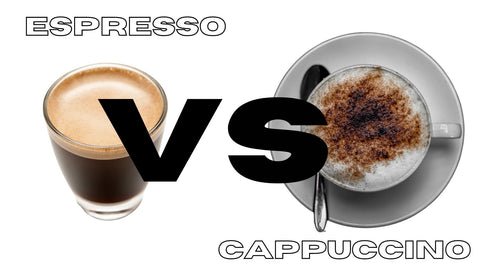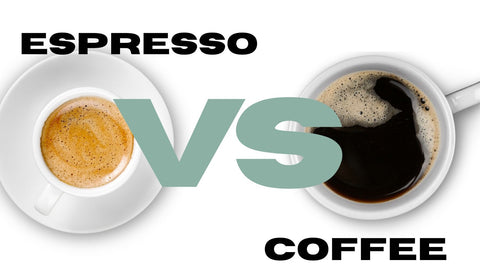Are you a fellow coffee lover navigating the world of coffee drinks, wondering about the differences between espresso and cappuccino?
This comprehensive guide examines the differences between the two popular coffee beverages that can't be missed from any cafe's offerings. In our espresso vs cappuccino showdown, you'll learn everything about the key aspects that make each drink unique.
For the more impatient coffee enthusiasts, here’s a Quick Answer:
QUICK ANSWER.......🢃˗ˏˋ☕ˎˊ˗
Espresso is a concentrated coffee shot without anything added, while cappuccino is an espresso-based drink with steamed milk and foam. There are many other espresso-based drinks like a latte macchiato, but in this article, we'll focus on comparing the bold flavor of espresso against the smooth flavor of a cappuccino.
If you would like to learn more about these two drinks, keep reading!
Espresso Basics
Origin & History
The word "espresso" (not expresso!!) has Italian origins. It refers to strong, concentrated, black coffee. The word can be translated as "pressed out" or "express," which makes sense because that’s what basically happens to make espresso.
This concentrated coffee shot has a shorter history than coffee in general. It can be traced back to early 20th-century Italy when Luigi Bezzera invented the drink. He wanted to find a way to prepare coffee faster. In his eyes, brewing coffee just took too long (that was in 1903).
After some tinkering, he discovered that adding some pressure to a regular coffee machine had two effects: He got his cup of coffee faster and stronger. His new coffee machine had a pretty "creative" name: the fast coffee machine.
Unfortunately, most people don’t associate Bezzera with inventing the espresso machine because a man called Desidero Pavoni ended up patenting the machine after he had bought some part of it from Bezzera.
The espresso didn't take long to gain popularity thanks to its quick preparation, intense flavor, and strong caffeine kick. Espresso machines revolutionized coffee culture. The small and mighty cup of coffee soon became a staple in cafes worldwide, and today, regular coffee isn't ordered that often in cafes any longer.
Flavor
Espresso coffee has a bold and robust flavor profile, which depends much on the beans' origin. The concentrated nature of the coffee drink highlights the unique characteristics of the coffee beans. Espresso is usually made with medium-dark or dark roasts, so you'll usually notice caramelly, chocolatey, and nutty hints (the longer beans roast, the more these flavors are drawn out).
In addition to the beans' origin and roast level of the roasted coffee beans, the flavor of espresso is influenced by the coffee bean type and which processing method has been used on them.
Texture
Straight espresso has a thicker consistency compared to other coffee drinks. The high pressure used in the espresso machine creates a velvety, creamy texture. The creamy texture of espresso is a result of the mixing of coffee oils and solids during the brewing process. This process gives you the signature crema: the golden-brown, slightly foamy layer that crowns a well-pulled shot of espresso.
Strength
If you're looking for a quick and strong coffee kick, you need espresso. Its concentrated form packs a caffeine punch that can instantly wake you up. Don't let its small size fool you: a single or double shot of espresso can deliver a powerful jolt of energy. Espresso is so strong because of the high-pressure brewing method. The finely ground coffee beans are subjected to approximately nine bars of pressure. This efficiently (and quickly) extracts the flavors and caffeine.
Cappuccino Basics
Origin & History
Cappuccino, a popular espresso-based drink, and espresso share their Italian origin. And you can't have a cappuccino without espresso. The drink's name comes from the Capuchin friars, whose brown robes resemble the drink's color. There is a legend that the drink was invented by one of these friars, but it's really more of a legend than an actual fact.
Like espresso, cappuccino became popular in the 20th century, but its global domination only started after the 1930s. Today, it's one of the most popular coffee drinks worldwide, and many baristas can proudly claim that they've taken part in a cappuccino competition to see who can produce the best art on a cappuccino's layer of foamy milk with some cocoa powder (and sometimes chocolate syrup). It's harder than it looks!
Flavor
Cappuccino offers a smooth and balanced flavor profile. It is a milder drinking experience than espresso, but its base is espresso. The combination of espresso, steamed hot milk, and milk foam creates a blend that still gives coffee lovers the flavor notes of espresso but in a slightly diluted version that doesn't have as much of a kick.
A cappuccino is fairly mellow and more approachable for the general coffee drinker (unless you add a double or triple shot, that's a different story).
The flavor of a cappuccino is influenced by the quality of the espresso shot and the type of milk used. Using coconut milk, for example, gives you a different flavor than oat milk or full-fat cow milk.
Texture
The texture of a cappuccino should be smooth and creamy. The steamed milk adds a velvety smoothness. It's a drink that combines the best of both worlds: the strength of espresso and the silkiness of steamed milk with a delicious sprinkling of cacao or cinnamon.
Foam Topping
One distinctive feature of a cappuccino is the thick layer of milk foam on top. This frothy layer makes the drink look appealing and adds to the overall texture and flavor.
The foam in a cappuccino is created by putting a steam wand into the milk, which heats and aerates it to create microbubbles. Unless the barista is a beginner or bad at their job, this process transforms the milk into a silky foam atop the espresso.
Milk Substitutes
Fortunately, cappuccino works well with most dairy-free alternatives. So, if you're vegan or have a lactose intolerance, you don't have to live without cappuccino. Some dairy-free milks work incredibly well, especially if you use barista versions designed to foam nicely.
Of course, some dairy-free alternatives influence the taste of cappuccino a little. Coconut milk makes it taste a little like coconut (surprise!). Almond milk is often watery, but it seems popular. Oat milk and soy milk are the best options for a great dairy-free cappuccino.
Of course, plain milk is what most baristas are originally trained with to make frothed milk, but today, most baristas should be able to create an awesome final drink without using whole milk from a cow.
Choose Your Coffee-Based Beverage
In the espresso vs cappuccino showdown, there isn't a winner. What you prefer ultimately depends on personal taste.
Are you looking for a bold and powerful coffee kick? Then go for one shot of espresso (typically served in a small cup). Or make it a double shot.
On the other hand, if you prefer a well-balanced and creamy delight that feels a little indulgent, the cappuccino is the perfect option.
And, of course, there's nothing wrong with loving both if you're an all-round coffee enthusiast!
Espresso vs Cappuccino: FAQ
Does a Cappuccino Have a Double Espresso Shot?
No, a traditional cappuccino (and also a latte macchiato) typically contains a single shot. However, you can ask the barista for an extra shot if you want a stronger drink.
Is a Cappuccino Stronger Than an Espresso?
It depends on what you mean. A single shot and a cappuccino have the same amount of caffeine because a cappuccino is based on one shot. However, adding the steamed milk and milk froth dilutes the espresso, giving you the impression it's the weaker drink.
But overall, to keep it simple, a serving of espresso and a cappuccino generally have the same amount of caffeine, but the espresso will taste stronger.


